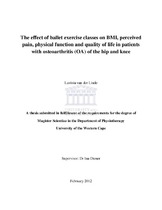| dc.description.abstract | Introduction: Osteoarthritis (OA) is one of the prevalent debilitating diseases in South Africa, often leading to activity limitations, participation restrictions and a poor quality of life. Older people often lead more sedentary lifestyles, which may further aggravate their symptoms. Exercise therapy has demonstrated good outcomes in the OA population. Many dance interventions have become popular in OA treatment and results suggest their effects to be more successful than traditional physiotherapy exercises regimes. Ballet dance exercises have not yet been explored in the treatment of OA, even though it has been proposed to have positive effects on the body. Purpose: to determine the effect of a program of ballet dance exercise classes on BMI, perceived pain, physical function and quality of life in patients with osteoarthritis (OA) of the hip and knee, compared to the existing Midros Clinic program of exercise classes. Methods: The study used a randomized, cross-sectional, quantitative, experimental study using pre- and post-intervention as well as multiple time-point testing. A sample of 52 males and females were recruited in Midros, Middelburg Cape. The inclusion criteria of the study were persons aged 65 years and older, with OA of the hip and/or knee, clinically diagnosed according to the criteria of the American College of Rheumatology. The VAS, Timed Up and Go Test (TUGT), WOMAC and the SF-8 Index, respectively measured reported perceived pain, physical function, quality of life and health status in the study groups. BMI, pulse and blood pressure were also recorded to further monitor the effects of the interventions. A comparable number of scores were obtained over six weeks of bi-weekly ballet exercise classes (intervention group = IG), and nine weeks of two-weekly exercise classes at the Midros Clinic (comparison group = CG). Descriptive statistics were used to analyse the demographic information and inferential statistics were used to determine the associations for parametric data; a two tailed p-value was calculated; the 95% CI was calculated using the approximation of Katz. The p-value was classified as significant if p<0.05. Results: The demographics and baseline measurements of the IG and CG were comparable. A series of five exercise classes (over nine weeks) had a significantly beneficial effect on BMI and systolic BP, perceived and actual physical function, and QOL, whereas a series of 12 ballet exercise classes ( over six weeks) had a significant positive effect on BMI and diastolic BP, perceived pain, perceived physical function, and QOL. The comparison of responses to the outcome measures by male and female participants demonstrated that, contrary to findings in the reviewed literature, females held more positive perceptions than males on their perceived severity of joint pain and function, physical and mental health, and well being. A series of the existing exercise classes of Midros Clinic brought about more significant changes than a program of ballet exercise classes in the research parameters measured, despite exercise classes taking place much less frequently than the ballet classes. Conclusion: Although both interventions were found to both bring about positive changes in older persons with OA, a series of ballet exercises classes did not result in better outcomes than the currently existing Midros Clinic group exercise classes. The results of the current study demonstrate that exercise interventions are found to be the most beneficial in improving the quality of life of OA sufferers. | en_US |

